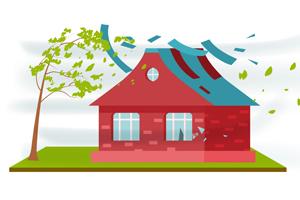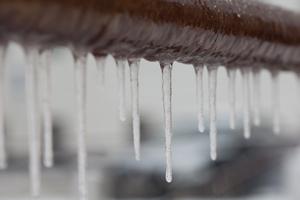Understanding wind deductibles

Wind – and the damage it can cause – affects every homeowner. As a result, most home insurance policies include some sort of wind damage deductible.
The source of that wind, though, can vary depending on where you live. Whether it was a hurricane or a winter storm that caused a tree to crash into your roof may not matter much to you. But it probably does to your policy, and it can determine the amount you pay out of pocket in the event of an insured loss due to wind damage.
So, it’s important to understand the various types of wind deductibles that may apply to a policy.
Hurricane deductibles |
Named storm deductibles |
Wind deductibles |
|---|---|---|
|
Apply to storms officially designated hurricanes by the U.S. National Weather Service |
Apply to storms officially “named” by the U.S. National Weather Service – hurricanes and tropical storms |
Apply to all wind damage, no matter how it was caused |
|
These storm-based deductibles are most prevalent in East Coast and Gulf Coast states, as well as Hawaii. |
One thing to keep in mind: The Weather Channel has, in the last few years, started to name winter storms. These are not official in the eyes of the U.S. National Weather Service, and thus a “named storm” deductible would not apply. |
These deductibles are more common in places that experience severe wind not caused by hurricanes and tropical storms. Think “Tornado Alley” in Texas and Oklahoma, or states in the Midwest. |
How wind deductibles work
Wind deductibles typically range from one to five percent of your home’s insured value. In the case of wind damage, your standard deductible would not apply and your wind deductible would kick in. The Insurance Information Institute offers more details on how wind deductibles work.
To help mitigate the cost of a wind deductible, some insurance carriers, including The Hanover, offer the following added-value coverage:
Waiver of deductible – With this coverage, you would only pay one deductible in the event a windstorm resulted in multiple claims. For instance, if high winds caused a tree to fall on your home and your car, you’d only pay the higher deductible, not both.
Siding and/or roof restoration coverage – This is coverage for the costs of replacing the entirety of siding or roofing after a claim when similar materials to be used for replacement are no longer available. Rather than having mismatched siding or roofing on your home, this coverage can help you keep a uniform look to your home’s exterior.
Equipment breakdown coverage – Windstorms are often accompanied by electrical surges or power outages. This coverage applies to major equipment in the home caused by electrical (and other) breakdowns not related to wear and tear. This applies both to installed devices (boilers, central air) and removable property, like laundry machines or your refrigerator.
Do you have a wind deductible?
A 2017 Insurance Research Council survey found that more than one-third of homeowners in coastal states had never heard of wind deductibles. Be in the know. Check your insurance policy’s declaration pages to find out if you have a wind or hurricane deductible.
The percentage figure of your wind deductible relates to your home’s insured value, and not the cost of a wind-related claim. As a result, homeowners can believe that this deductible is much lower than it actually is.
Wind deductibles are often paired with hail to create one deductible that takes effect in either event.
Don’t blow it
Talk to your independent insurance agent today to see just how much a windstorm could end up costing you, and steps you can take to minimize the impact of wind damage.
LC 2018-279
Related resources
Understanding wind deductibles
Wind – and the damage it can cause – affects every homeowner. As a result, most home insurance policies include some sort of wind damage deductible.
The source of that wind, though, can vary depending on where you live. Whether it was a hurricane or a winter storm that caused a tree to crash into your roof may not matter much to you. But it probably does to your policy, and it can determine the amount you pay out of pocket in the event of an insured loss due to wind damage.
So, it’s important to understand the various types of wind deductibles that may apply to a policy.
Hurricane deductibles |
Named storm deductibles |
Wind deductibles |
|---|---|---|
|
Apply to storms officially designated hurricanes by the U.S. National Weather Service |
Apply to storms officially “named” by the U.S. National Weather Service – hurricanes and tropical storms |
Apply to all wind damage, no matter how it was caused |
|
These storm-based deductibles are most prevalent in East Coast and Gulf Coast states, as well as Hawaii. |
One thing to keep in mind: The Weather Channel has, in the last few years, started to name winter storms. These are not official in the eyes of the U.S. National Weather Service, and thus a “named storm” deductible would not apply. |
These deductibles are more common in places that experience severe wind not caused by hurricanes and tropical storms. Think “Tornado Alley” in Texas and Oklahoma, or states in the Midwest. |
How wind deductibles work
Wind deductibles typically range from one to five percent of your home’s insured value. In the case of wind damage, your standard deductible would not apply and your wind deductible would kick in. The Insurance Information Institute offers more details on how wind deductibles work.
To help mitigate the cost of a wind deductible, some insurance carriers, including The Hanover, offer the following added-value coverage:
Waiver of deductible – With this coverage, you would only pay one deductible in the event a windstorm resulted in multiple claims. For instance, if high winds caused a tree to fall on your home and your car, you’d only pay the higher deductible, not both.
Siding and/or roof restoration coverage – This is coverage for the costs of replacing the entirety of siding or roofing after a claim when similar materials to be used for replacement are no longer available. Rather than having mismatched siding or roofing on your home, this coverage can help you keep a uniform look to your home’s exterior.
Equipment breakdown coverage – Windstorms are often accompanied by electrical surges or power outages. This coverage applies to major equipment in the home caused by electrical (and other) breakdowns not related to wear and tear. This applies both to installed devices (boilers, central air) and removable property, like laundry machines or your refrigerator.
Do you have a wind deductible?
A 2017 Insurance Research Council survey found that more than one-third of homeowners in coastal states had never heard of wind deductibles. Be in the know. Check your insurance policy’s declaration pages to find out if you have a wind or hurricane deductible.
The percentage figure of your wind deductible relates to your home’s insured value, and not the cost of a wind-related claim. As a result, homeowners can believe that this deductible is much lower than it actually is.
Wind deductibles are often paired with hail to create one deductible that takes effect in either event.
Don’t blow it
Talk to your independent insurance agent today to see just how much a windstorm could end up costing you, and steps you can take to minimize the impact of wind damage.
LC 2018-279
Related resources
Understanding wind deductibles
Wind – and the damage it can cause – affects every homeowner. As a result, most home insurance policies include some sort of wind damage deductible.
The source of that wind, though, can vary depending on where you live. Whether it was a hurricane or a winter storm that caused a tree to crash into your roof may not matter much to you. But it probably does to your policy, and it can determine the amount you pay out of pocket in the event of an insured loss due to wind damage.
So, it’s important to understand the various types of wind deductibles that may apply to a policy.
Hurricane deductibles |
Named storm deductibles |
Wind deductibles |
|---|---|---|
|
Apply to storms officially designated hurricanes by the U.S. National Weather Service |
Apply to storms officially “named” by the U.S. National Weather Service – hurricanes and tropical storms |
Apply to all wind damage, no matter how it was caused |
|
These storm-based deductibles are most prevalent in East Coast and Gulf Coast states, as well as Hawaii. |
One thing to keep in mind: The Weather Channel has, in the last few years, started to name winter storms. These are not official in the eyes of the U.S. National Weather Service, and thus a “named storm” deductible would not apply. |
These deductibles are more common in places that experience severe wind not caused by hurricanes and tropical storms. Think “Tornado Alley” in Texas and Oklahoma, or states in the Midwest. |
How wind deductibles work
Wind deductibles typically range from one to five percent of your home’s insured value. In the case of wind damage, your standard deductible would not apply and your wind deductible would kick in. The Insurance Information Institute offers more details on how wind deductibles work.
To help mitigate the cost of a wind deductible, some insurance carriers, including The Hanover, offer the following added-value coverage:
Waiver of deductible – With this coverage, you would only pay one deductible in the event a windstorm resulted in multiple claims. For instance, if high winds caused a tree to fall on your home and your car, you’d only pay the higher deductible, not both.
Siding and/or roof restoration coverage – This is coverage for the costs of replacing the entirety of siding or roofing after a claim when similar materials to be used for replacement are no longer available. Rather than having mismatched siding or roofing on your home, this coverage can help you keep a uniform look to your home’s exterior.
Equipment breakdown coverage – Windstorms are often accompanied by electrical surges or power outages. This coverage applies to major equipment in the home caused by electrical (and other) breakdowns not related to wear and tear. This applies both to installed devices (boilers, central air) and removable property, like laundry machines or your refrigerator.
Do you have a wind deductible?
A 2017 Insurance Research Council survey found that more than one-third of homeowners in coastal states had never heard of wind deductibles. Be in the know. Check your insurance policy’s declaration pages to find out if you have a wind or hurricane deductible.
The percentage figure of your wind deductible relates to your home’s insured value, and not the cost of a wind-related claim. As a result, homeowners can believe that this deductible is much lower than it actually is.
Wind deductibles are often paired with hail to create one deductible that takes effect in either event.
Don’t blow it
Talk to your independent insurance agent today to see just how much a windstorm could end up costing you, and steps you can take to minimize the impact of wind damage.
LC 2018-279
Related resources
Understanding wind deductibles
Wind – and the damage it can cause – affects every homeowner. As a result, most home insurance policies include some sort of wind damage deductible.
The source of that wind, though, can vary depending on where you live. Whether it was a hurricane or a winter storm that caused a tree to crash into your roof may not matter much to you. But it probably does to your policy, and it can determine the amount you pay out of pocket in the event of an insured loss due to wind damage.
So, it’s important to understand the various types of wind deductibles that may apply to a policy.
Hurricane deductibles |
Named storm deductibles |
Wind deductibles |
|---|---|---|
|
Apply to storms officially designated hurricanes by the U.S. National Weather Service |
Apply to storms officially “named” by the U.S. National Weather Service – hurricanes and tropical storms |
Apply to all wind damage, no matter how it was caused |
|
These storm-based deductibles are most prevalent in East Coast and Gulf Coast states, as well as Hawaii. |
One thing to keep in mind: The Weather Channel has, in the last few years, started to name winter storms. These are not official in the eyes of the U.S. National Weather Service, and thus a “named storm” deductible would not apply. |
These deductibles are more common in places that experience severe wind not caused by hurricanes and tropical storms. Think “Tornado Alley” in Texas and Oklahoma, or states in the Midwest. |
How wind deductibles work
Wind deductibles typically range from one to five percent of your home’s insured value. In the case of wind damage, your standard deductible would not apply and your wind deductible would kick in. The Insurance Information Institute offers more details on how wind deductibles work.
To help mitigate the cost of a wind deductible, some insurance carriers, including The Hanover, offer the following added-value coverage:
Waiver of deductible – With this coverage, you would only pay one deductible in the event a windstorm resulted in multiple claims. For instance, if high winds caused a tree to fall on your home and your car, you’d only pay the higher deductible, not both.
Siding and/or roof restoration coverage – This is coverage for the costs of replacing the entirety of siding or roofing after a claim when similar materials to be used for replacement are no longer available. Rather than having mismatched siding or roofing on your home, this coverage can help you keep a uniform look to your home’s exterior.
Equipment breakdown coverage – Windstorms are often accompanied by electrical surges or power outages. This coverage applies to major equipment in the home caused by electrical (and other) breakdowns not related to wear and tear. This applies both to installed devices (boilers, central air) and removable property, like laundry machines or your refrigerator.
Do you have a wind deductible?
A 2017 Insurance Research Council survey found that more than one-third of homeowners in coastal states had never heard of wind deductibles. Be in the know. Check your insurance policy’s declaration pages to find out if you have a wind or hurricane deductible.
The percentage figure of your wind deductible relates to your home’s insured value, and not the cost of a wind-related claim. As a result, homeowners can believe that this deductible is much lower than it actually is.
Wind deductibles are often paired with hail to create one deductible that takes effect in either event.
Don’t blow it
Talk to your independent insurance agent today to see just how much a windstorm could end up costing you, and steps you can take to minimize the impact of wind damage.
LC 2018-279





